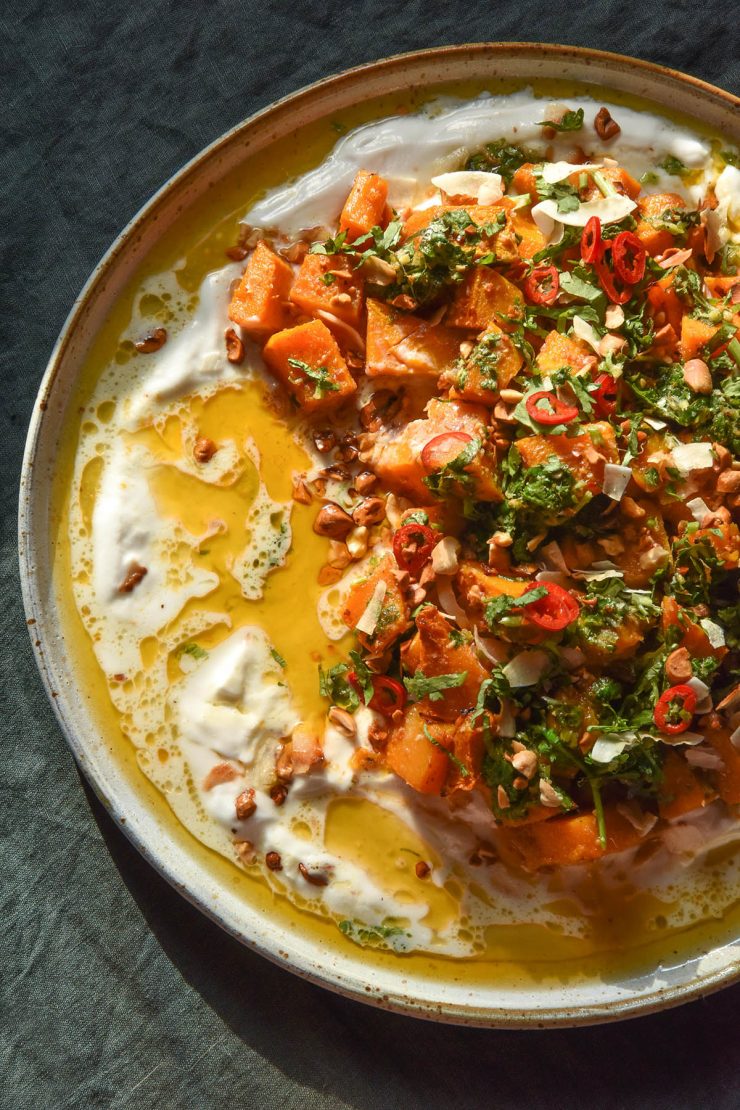
This red Thai curry roasted pumpkin is inspired by an Ottolenghi salsa I made for Christmas. It is part of his recipe for makrut lime hasselback beetroots which I found on the Guardian website.
The salsa is a mix of coriander, garlic, ginger, makrut lime leaves and oil. As I always end up doing (often to my own detriment) I decided to put a bit of my own spin on the salsa. I added makrut lime zest, fresh lime zest and lime juice. The result? The best salsa I have had in a long time.

Red Thai Curry roasted pumpkin
So, the concept of this dish sprung from the deliciousness of the salsa. I decided I wanted to drizzle it over pumpkin, and figured the spicy Red curry paste would contrast beautifully with the fresh salsa.
To complement the flavours, the dish has a base of coconut yoghurt and is topped with toasted peanuts and some optional toasted coconut. It is fresh, spicy, vibrant and bright all at once. A delicious side dish that looks absolutely beautiful on the table.
This Red Thai curry roasted pumpkin dish is easily vegan, gluten free and easily low FODMAP. It can also be adapted to be nut free or coconut free if need be.
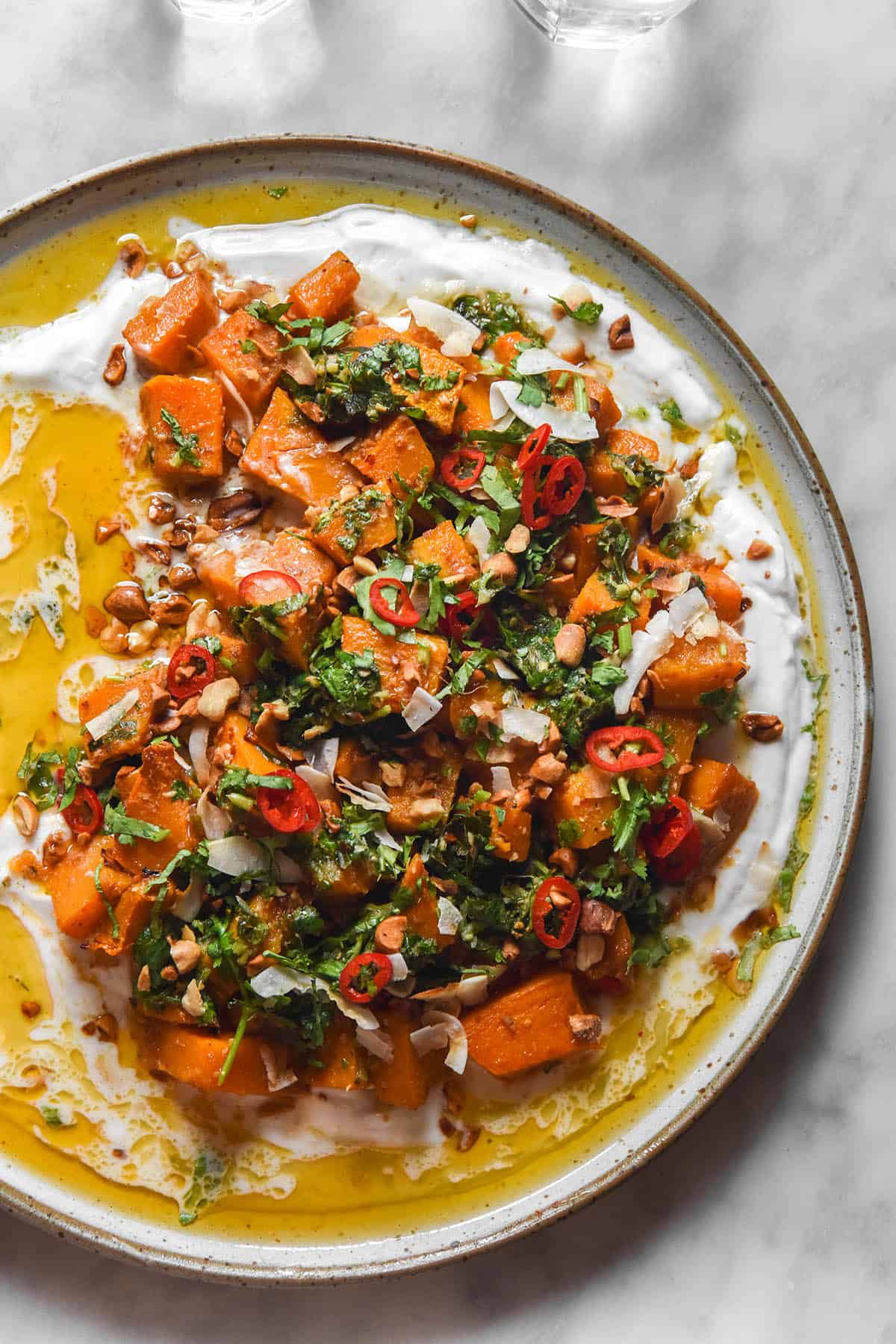
FODMAP notes for this Red Thai curry roasted pumpkin
Although this recipe does not need to be low FODMAP, it is easily made with FODMAPs in mind. Firstly, I have a recipe for low FODMAP Red Thai curry paste. It is easy to make in a food processor and keeps brilliantly in the freezer for occasions like these.
Monash has recently (as of November 2024) updated their entry for Japanese/Kent pumpkin. It is low FODMAP in serves of 75g and up to 161g. In serves of 162g or more, it contains moderate amounts of fructans. It was previously 500g per person.
Monash states that coconut yoghurt is low FODMAP in 125g serves. However, they don’t specify whether they chose a brand with a high FODMAP ingredient like inulin. If you can, try to choose a brand that does not contain inulin. In Australia, brands that don’t seem to include inulin are Nakula and Coles brand, but be sure to check the label. Some also contain chicory, which is another high FODMAP ingredient.
In terms of the salsa, I choose to infuse the oil with garlic and remove the cloves before serving. This keeps the salsa low FODMAP. Of course, if you have no FODMAP constraints, you can easily keep the garlic in. Be sure not to overcook it if you do.
Last but not least: the (optional) toasted coconut topping. Shredded coconut is low FODMAP in 30g serves, or around 1/2 cup. This recipe contains less than that amount in total and serves 4-6 as a side.
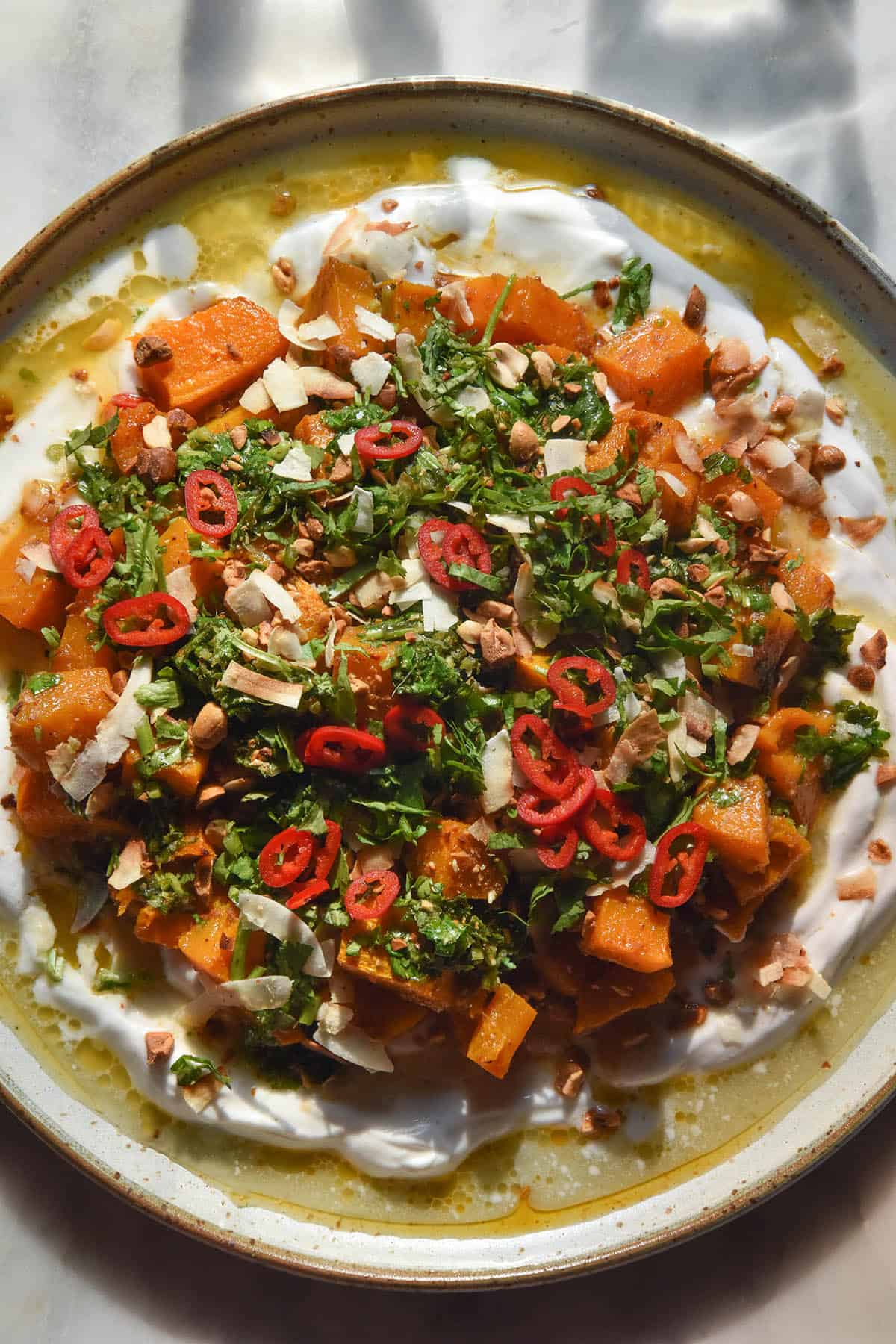
Substitution options
First and foremost: if you’re looking to this recipe as a vegan dish, check your red curry paste. Many have shrimp paste or fish sauce (or both) so choose a vegan brand. I have a low FODMAP vegan Thai red curry paste recipe here, but I daresay there are plenty of vegan recipes online.
If you’re not a coconut fan or have an allergy to coconut, you can use another variety of plant based yoghurt or regular plain yoghurt. Jalna make lactose free Greek yoghurt which is what I normally buy.
For those who need the dish to be nut free, simply omit the nuts. You can substitute with toasted sesame seeds or even hemp seeds if you like.
If you are vehemently against coriander, I recommend Thai basil or Vietnamese mint. Where those are not accessible, I reluctantly suggest regular mint (although the coriander isn’t overpowering, I promise!)
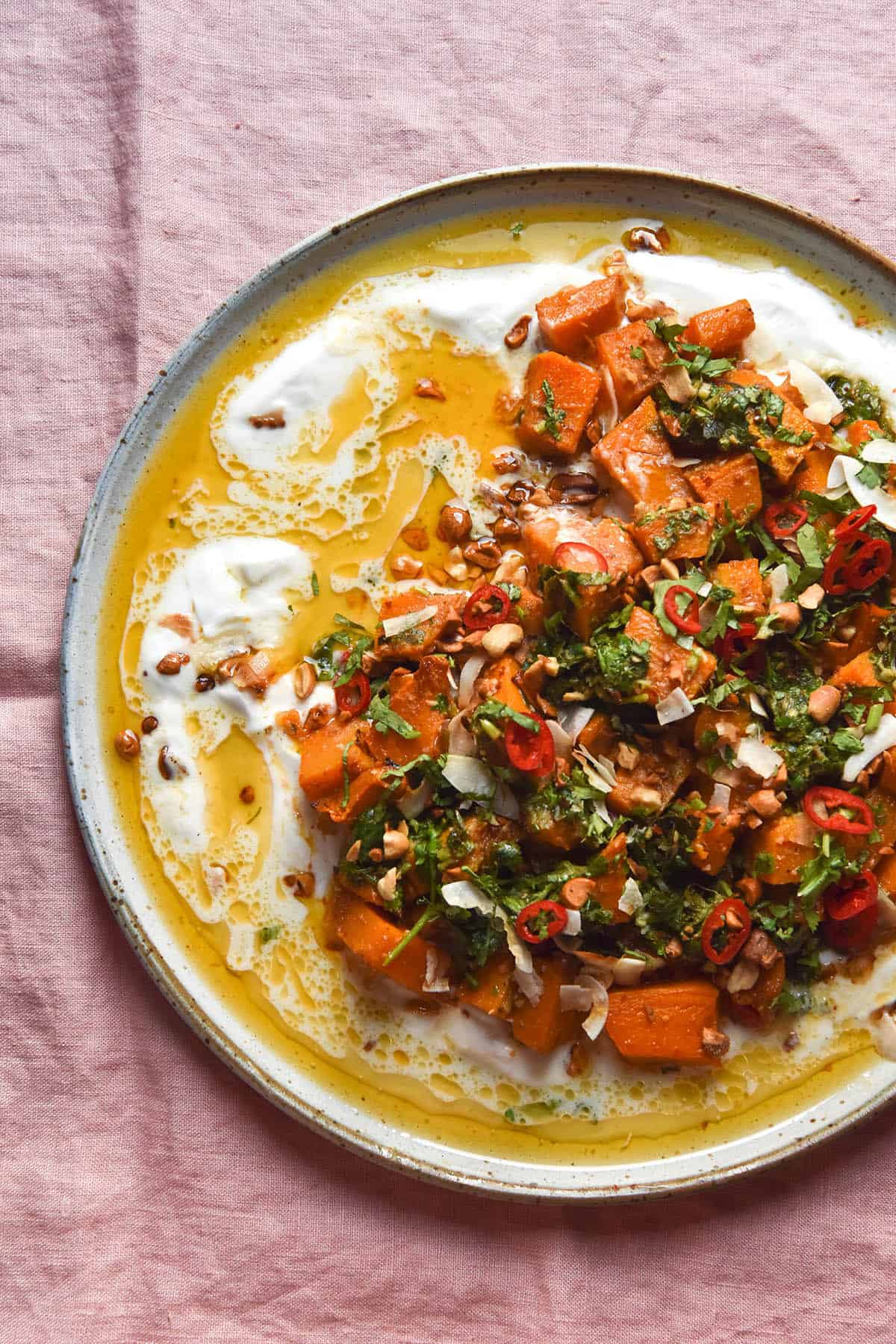
More vegetarian and vegan recipes
- Low FODMAP Thai green curry
- Gluten free, low FODMAP and vegetarian or vegan Pad Thai
- Low FODMAP Red Thai curry
- Low FODMAP vegetarian curry
- Gluten free bao buns
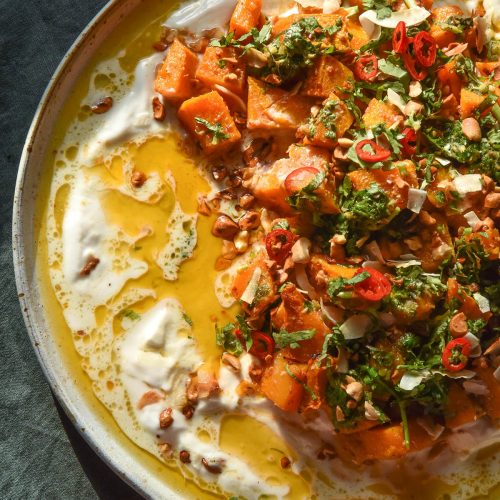
Thai red curry roasted pumpkin
Ingredients
For the pumpkin:
- 1 kg Japanese or Kent pumpkin
- 2 teaspoons red Thai curry paste, to taste (see notes)
- 20-40 ml (2-3 tablespoons)* neutral oil I used vegetable oil
- 1 teaspoon maple syrup
- Salt to your tastes
For the infused oil:
- 60 ml (3 tablespoons)* neutral oil (I used vegetable oil)
- 2 cloves garlic
- 3 slices of ginger
- 5 makrut lime leaves
For the salsa:
- Infused oil (above) strained
- 5 makrut lime leaves finely chopped
- Makrut lime zest to taste (see notes)
- 1/2 bunch coriander washed and chopped
- Extra grated ginger to your tastes
- 40-60 ml (2-3 tablespoons)* fresh lime juice to taste
- 1/2 teaspoons white sugar to taste
- Salt and pepper to taste
To finish:
- 500 g plain coconut yoghurt (see notes)
- 50-100 g chopped roasted peanuts
- 10-20 g toasted coconut optional, for garnish
- 1 red chilli finely sliced (optional, for garnish)
Instructions
For the pumpkin:
- Preheat the oven to 200C/400F. Whisk together the oil, red Thai curry paste, maple syrup and salt.
- Place the cubed pumpkin on a tray and spread the oil mixture over the top. Place into the oven for 20-30 minutes or until the pumpkin is just soft.
For the infused oil:
- Combine the ingredients in a small pot over a medium heat. Cook for 5-10 minutes or until the garlic is golden brown. Strain and discard (you can finish the dish with the crunchy garlic if you don’t need it to be low FODMAP).
For the salsa:
- Combine all ingredients in a medium bowl and adjust according to your tastes.
To finish:
- Spread the coconut yoghurt on a serving platter. Top this with the pumpkin, then drizzle over the salsa. Finish with the peanuts, optional toasted coconut and red chilli and serve.
Notes
- Most store bought red Thai curry pastes contain shrimp. Try to find a version without shrimp or fish sauce for vegetarian/vegan diners or for shellfish allergies. My low FODMAP vegan recipe can be found here.
- Curry pastes vary hugely in their spice level. Add according to your preferences.
- Makrut lime leaves (previously known as kaffir lime leaves) are generally available at Australian supermarkets. I buy large frozen packs at Asian grocers to keep me going year round.
- Makrut limes are harder to find, but worth sourcing. They store really well in the freezer so you can use the zest year round. You can substitute regular lime zest if you can’t find this, or just omit.
- If you don’t like coconut, you can use another plant based yoghurt or plain regular yoghurt. For low FODMAP, use a lactose free variety like Jalna lactose free Greek yoghurt (my go-to).

No Comments